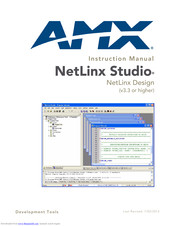Amx NetLinx Studio Manuals
Manuals and User Guides for Amx NetLinx Studio. We have 1 Amx NetLinx Studio manual available for free PDF download: Instruction Manual
Amx NetLinx Studio Instruction Manual (230 pages)
NetLinx Design v3.3 or higher
Table of Contents
-
-
Overview
13 -
-
Title Bar15
-
Menu Bar16
-
Toolbars16
-
Output Bar18
-
Watch Bar18
-
Status Bar19
-
-
-
Workspaces20
-
Projects20
-
Systems21
-
System Files21
-
-
-
-
Overview
23
-
-
-
Overview
37
-
-
-
Overview
41
-
-
-
Overview
47 -
-
-
Programming
83-
Edit Options
85 -
Call Tips
94 -
-
-
Using FORMAT113
-
-
-
-
Overview
131
-
-
-
-
Overview
161-
USB Transfers161
-
-
-
-
-
-
Overview
179 -
Emulate a Device
184 -
Control a Device
185 -
URL Listing
189
-
-
-
Overview
197 -
Amx-Pi
198 -
DIP Switch
198 -
File Extraction
200 -
Find in Files
202 -
View Readme
207
-
-
-
Overview
209 -
-
Advertisement
Advertisement
